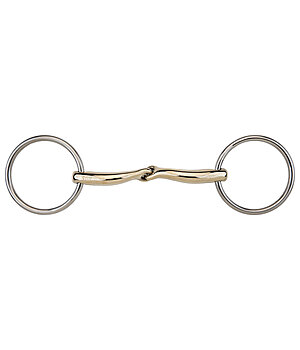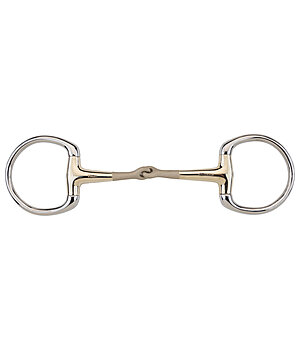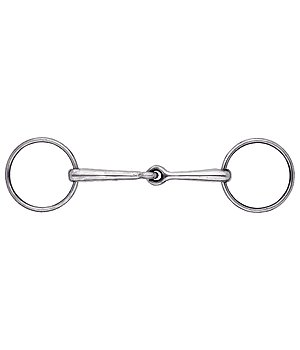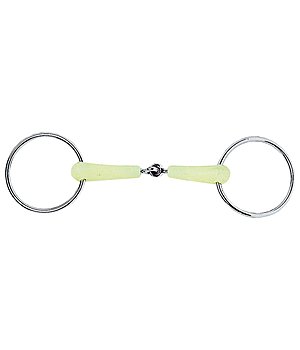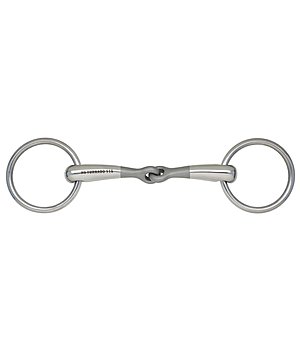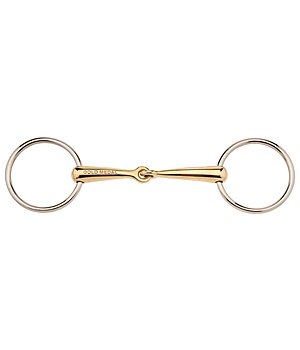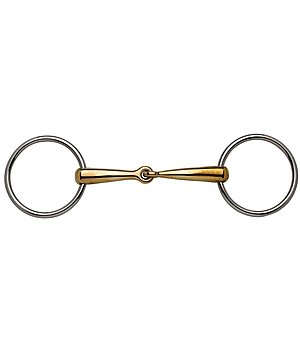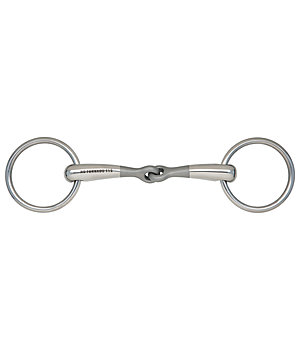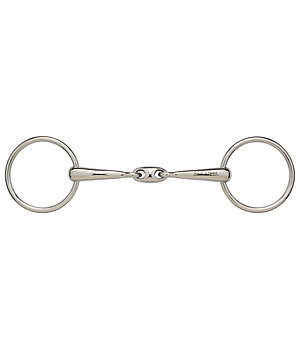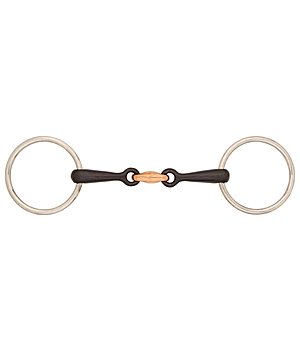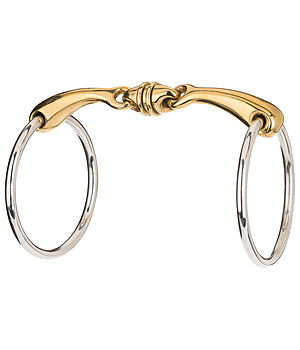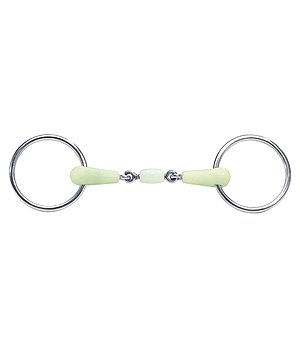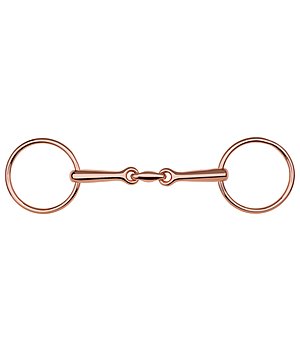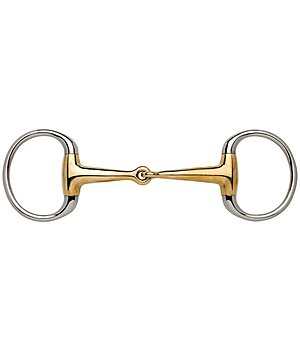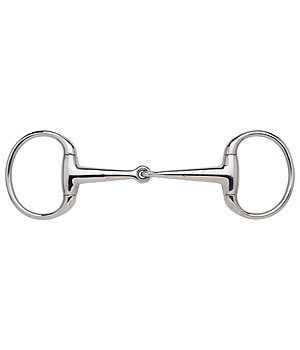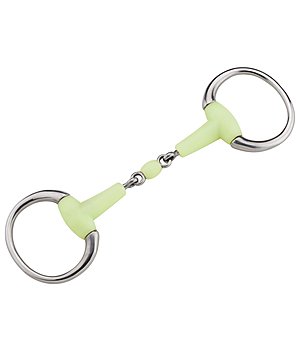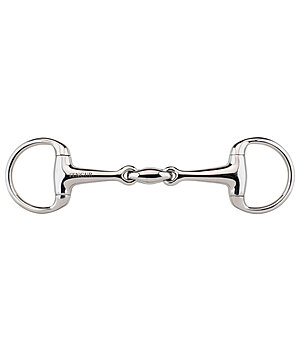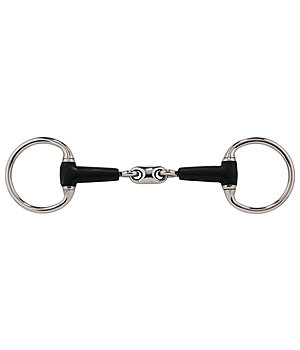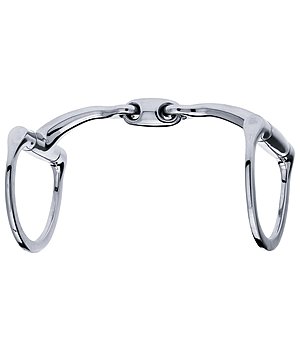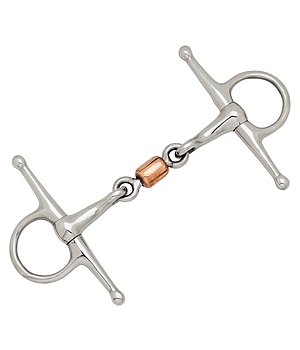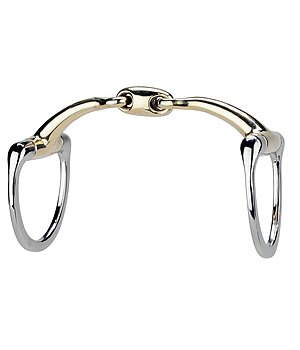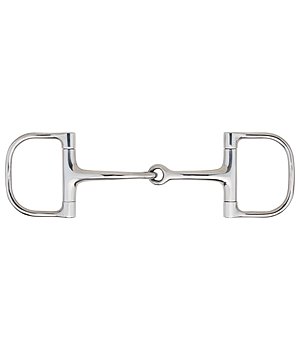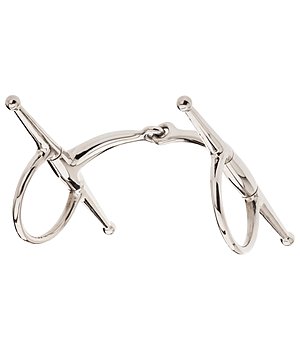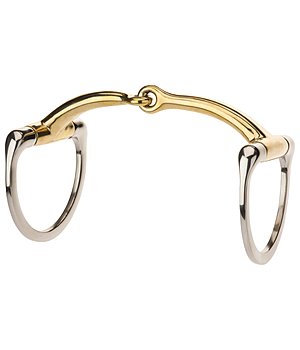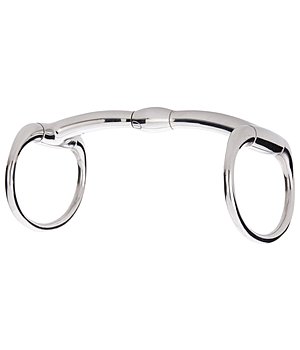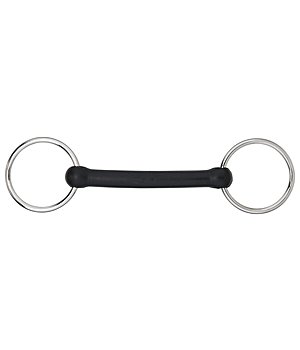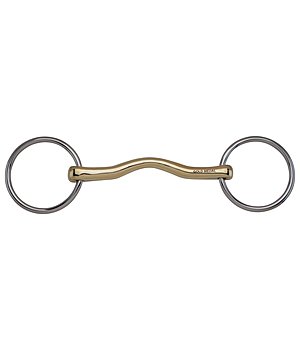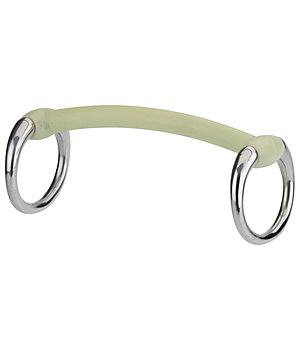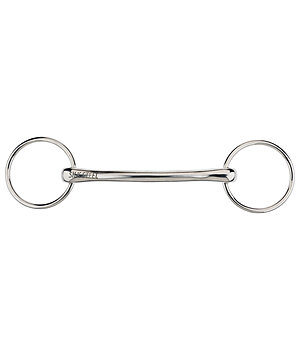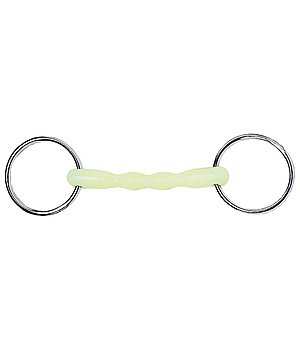Various types of horse bits and their effect
The majority of riders use a bridle with a bit to communicate with the horse. As with the saddle, a critical eye must be kept when choosing the right bit to ensure that it matches the horse’s mouth, the horse’s character, the training level of horse and rider and the training objective. After all, the bit is a foreign object in the horse’s mouth, which is extremely sensitive due to its teeth and thin mucous membranes. In this guide, we will therefore explain why a quality bit is absolutely necessary and give you an overview of which bits would be suitable for your horse.

Why a quality bit is so important
The bit is attached to the cheek pieces in the bridle and lies in the horse’s mouth in the tooth-free cavity between the molars and incisors – in what is known as the bars. The reins are buckled into the bit rings below the cheek pieces. When the bit is buckled correctly, it lies quietly in the middle of the mouth, does not make the horse „grin“, but also does not sit loosely allowing the horse to play with it and put their tongue over it continuously.
The correct buckling of the bridle is essential for the correct positioning of the bit in the horse’s mouth. How to adjust a bridle to the size of your horse’s head can be found in our bridle guide.
For clear communication between rider and horse, many riders use a horse bit. Alternatively, you can also ride bitless – you can discover the possibilities of bitless riding in the corresponding guidebook. Since the bit can be the bridge to fine communication when riding, it is important to remember that the horse’s mouth is a particularly sensitive area. The mucous membranes are extremely thin and the bit lies directly on the tongue with its many nerves. If the bit is too big for the horse’s mouth, it can press directly on the jaws, i.e. the bone, and cause pain. If, on the other hand, the snaffle bit is too small, it pulls uncomfortably into the corners of the mouth and pinches the lips.
A good bit is also characterised by the fact that its surface is intact, otherwise injuries can occur in the mouth.
In addition to the size and make of the bit, the material is often underestimated. This is because the contact between saliva and bit can cause allergic reactions in the horse, which can manifest as redness, blisters and bald patches around the mouth. So you should also think about suitable materials for a bit.
With a good fitting bit, the horse feels comfortable, whereupon it is rideable and achieves suppleness and consequently responsiveness more easily and quickly. It is therefore of utmost importance that both the bit fits optimally and the rider is aware of the sensitivity of the horse’s mouth.
In addition to the precise fit of the bit, a correctly trained horse and a sensitive rider’s hand are always a prerequisite for the horse-friendly use of a bit. Every rider should treat this subject with the utmost care. The rider must listen to their horse and not misuse the bit to compensate for their own inadequacies. Once a bit has been selected and fitted, it still does not mean to avoid regular follow-ups.
The various types of bits and their effect
There are an abundance of bits on the market, which differ from each other by their design and effect, construction, size and material. However, this medley of bits is justified, as the choice of bit depends on the level of training of rider and horse, riding style, anatomical conditions and preferences of the horse. Below we have listed the most important and most common types of bits and their effect.
- Loose Ring Snaffle Bit
- Eggbutt Bit
- D-Ring Snaffle Bit
- Mullen Mouth Bit
- Pelham
- Weymouth Bit
- Baucher Bit
Single and double jointed loose ring snaffle bits
Loose ring snaffle bit get their name from the fact that they have rings running through them. They come in single jointed or double jointed form. In a single jointed loose ring snaffle bit, the mouthpiece consists of two bit parts of equal length, which are connected to each other by a movable joint. In contrast, in a double jointed loose ring snaffle bit, a small mouthpiece is placed between them, so that we have two joints.
Effect: A single jointed loose ring snaffle bit acts on the tongue and the lower jaw. One of the greatest advantages of a loose ring snaffle bit is the independence of the one-sided rein aid. If the rein is shortened on one side, only the corresponding side of the bit moves due to the joint and points the horse in that direction. This allows for clearly separated aids. When pulling on both reins, the joint slides up the middle of the mouth and can build up pressure on the palate.
In the past, it was believed that this caused the bit to tilt, the so-called „nutcracker effect“. However, this is only the case with bits that are too thick or too big. This is because with a single jointed bit, the horse can escape the pressure by lifting its tongue and prevent the bit from tilting.

SELECTION OF SINGLE JOINTED SNAFFLE BITS

With a double jointed snaffle bit, the mouthpiece lies on a large surface and surrounds the tongue more closely. This means that the bit lies more calmly in the horse’s mouth, but at the same time exerts a slight, constant pressure – even when the reins are given. Accordingly, a double jointed snaffle bit has a less concentrated effect and can therefore easily dilute the aids.
The continuous rings can cushion an unsteady rider’s hand somewhat. For this reason, a loose ring snaffle bit with a single joint is the bit of choice for beginners as well as for young horses.
SELECTION OF DOUBLE JOINTED SNAFFLE BITS
Eggbutt Bit
An eggbutt bit differs from a loose ring bit only in its fixed side pieces. The mouthpieces run slightly wider towards the outside and then merge into the bit rings, which are firmly connected to the mouthpiece via a hinge joint. Eggbutt bits are not suitable for every horse due to their thickness, as especially horses with small/narrow mouths have a lot of metal in their mouths with an eggbutt bit. A good alternative to this style would be a D-ring snaffle bit. An eggbutt bit is available in both single and double jointed variations.

Effect: Due to its fixed rings, an eggbutt snaffle bit offers the horse more lateral guidance and limitation than a loose ring snaffle bit with continuous rings. Therefore a more direct effect on the lower jaw and tongue is possible, the signals reach the horse faster and more clearly. One could therefore say that an eggbutt bit has a stronger effect than a loose ring snaffle bit.
SELECTION OF EGGBUTT SNAFFLE BITS
D-Ring Snaffle Bit

A slight variation of the eggbutt bit is the D-ring snaffle bit, which gets its name from the solid side pieces that have the shape of the letter D. The mouthpiece does not thicken towards the ring as in the eggbutt bit, but remains narrow. D-ring snaffle bits are therefore also well suited for horses with little space in the mouth.
Effect: The D-shaped side pieces provide lateral containment. The longer the side pieces are, the stronger the lateral contact. If the rein is shortened on one side, the opposite ring does not pull into the mouth as with continuous rings and does not pinch the mouth.
Instead, the pressure is distributed along the mouth and the horse is pushed, so to speak, from the opposite side in the direction of the rein. A full cheek snaffle bit has a similar effect. This gives even more lateral restraint due to its long shanks, which have no leverage effect.
A D-ring snaffle bit is therefore particularly recommended for stiff horses that do not want to bend for physical or psychological reasons.
SELECTION OF D-RING AND FULL CHEEK SNAFFLE BITS
Mullen Mouth Bit
A mullen mouth bit consists of a fixed mouthpiece without a movable joint. The side pieces can be fixed or continuous rings. With a mullen mouth bit, the correct choice of bit width is particularly important, as otherwise a bit that is too large will press hard on the edges of the tongue and the lower jaw.
Effect: The mullen mouth bit lies evenly on the tongue and distributes the pressure steadily over the entire width of the tongue, even on a loose rein.

Flexion and bending of the horse is only possible to a limited extent with a mullen mouth bit, as the bit tilts and twists when only one rein is shortened. As a result, it presses on the opposite side of the upper bar. For this reason, a mullen mouth bit is more suitable for horses that are well trained and can be flexed and bended with fine aids without a lot of effort.

A special form of mullen mouth bit is the kimblewick bit.
Thanks to the three ways in which the reins can be buckled into the bit rings, a kimblewick targets three different points of action: Tooth-free interspace of the jaw and tongue; lower jaw and chin; neck.
The kimblewick is very suitable for training as a precursor to the weymouth bit.
SELECTION OF MULLEN MOUTH BITS
Pelham
A pelham is a combination of a snaffle bit and a weymouth bit with a leverage effect, but unlike a weymouth bit it is used without a bradoon. The pelham is available as a mullen mouth, double or single jointed bit and is correctly ridden with four reins. It can also be used with pelham roundings with only one pair of reins. With this type of buckling, the aids are strongly diluted, which is why a pelham with only one pair of reins can only be used for controlling strong horses.

Effect: The pelham is ridden with a curb chain so that there is a limitation of leverage from an angle of 45 degrees. The rein buckled directly to the mouthpiece acts on the lower jaw, the second pair of reins buckled to the lower part of the shanks acts on the the neck. The jointed version of the pelham also has an effect on the corners of the mouth. It is therefore advisable to use bit guards to avoid pinching the lips.
Due to its leverage effect, the pelham is classified as a severe bit and therefore only belongs in experienced hands. If you use the pelham as a „brake“, you should think about an appropriate training of the horse, as the use of the pelham in this case is not a permanent solution. Otherwise, the jointed version is a very good bit for horses that are difficult to bend or lean on the bit.
Weymouth Bit

The weymouth bit is a bit consisting of a continuous piece of metal with one upper and one lower shank. It is used with two pairs of reins and a curb chain. Furthermore, a bradoon is required for the use of a weymouth bit.
Effect: When the weymouth rein, which is buckled into the lower shank, is shortened, the upper shank tilts forward and exerts pressure over the cheek piece. As a result, the point of action in the neck is addressed – the horse gives way in the neck and understands more easily that it should shift its weight backwards. In order to limit the leverage effect and not to come as a surprise to the horse, the curb chain should be buckled in such a way that it responds at an angle of 45° between the weymouth shank and the cleft of the mouth.
For bits with curved shanks (e.g. Western bits with shanks) you can use the half way point of the shanks as a guide.
The bridle reins, on the other hand, which are buckled in to the bradoon, act on the tongue and the lower jaw. This makes finer, more differentiated aids possible, which is not the case with the pelham.
The weymouth bit is a very fine instrument that can show a very well trained horse the way to collection. For this reason, the weymouth bit is mainly used by dressage riders during advanced exercises. In conclusion, a weymouth bit does not belong in the hands of beginners or in the mouth of a young horse.
Please note: The weymouth bit is by no means used as a brake or for better controlling a horse, but to refine the aids.
Baucher Bit
The baucher bit is often used in baroque and Spanish riding. Also known as a fillis bit, it is available as a single or double jointed bit or as a mullen mouth bit and has a short upper shank but no lower shank.
The cheek piece is attached to the small upper shank, while the reins are buckled into the bit rings. The baucher bit is used without a curb chain.

Effect: Due to the suspension in the upper rings, even a jointed baucher bit lies very still in the horse’s mouth. This is especially advantageous for horses with canine and wolf teeth, because when the reins are shortened, the bit does not tilt towards these teeth. Due to its quiet position, it takes up little space in the mouth like a mullen mouth bit, but acts (laterally) like a snaffle bit. A baucher bit can therefore also be used as a bradoon for a weymouth bit, as the two bits do not collide.
At the same time, the b-shaped side part offers a slight limitation and thus has a sideways effect, similar to a full cheek bit.
Although the baucher bit has an upper shank, it does not have an effect on the neck. This is because when the reins are shortened, there is a pull on the bit rings, the upper shank folds slightly forward outwards, which loosens the cheek pieces and thus does not create pressure in the neck. It has much more of an effect by tilting forward on the corners of the mouth and has a slightly elevating effect.

Which is better – a single jointed bit or a double jointed bit?
Very few riders ride their horse with a weymouth bit or any other bit with shanks. Single and double jointed loose ring snaffle bits are among the most commonly purchased bits. Originally, it was widely believed that a double jointed bit was preferable to a single jointed bit. This was because a single jointed bit could lead to the „nutcracker effect“ when pulled. It is true that when the rein is shortened, the single joint can rise up like a roof and dig into the palate, while the sides press into the lower jaws. However, the horse can escape this pressure by lifting the bit upwards with the tongue, thus pushing it away from its jaws.
This is not possible with a double jointed bit. The bit encloses the tongue and the horse cannot escape the pressure by lifting the tongue. Even when the reins are loose, the bit lies on a wide surface and exerts pressure. If the reins are pulled, the pressure on the mouth and tongue of a double jointed bit can even cause bruising in the worst case.
It is impossible to say which of the two types of bit is better. The mouthpiece must always be judged in connection with the side pieces and the rider’s hand. You can read about how to find the right bit in the next chapter.



